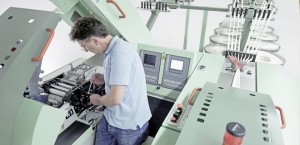 Spinning mills must increasingly react quickly to customer requirements. Even fewer faults in the yarn are accepted. The increasing demands are met by the new RSB-D 24 autoleveller draw frame. Convenient setting of the suction intensity and delivery speed on the display, a sliver sensor for which a patent is pending, the energy-saving suction system ECOrized and independent maintenance of the machine sides are features that support our customers.
Spinning mills must increasingly react quickly to customer requirements. Even fewer faults in the yarn are accepted. The increasing demands are met by the new RSB-D 24 autoleveller draw frame. Convenient setting of the suction intensity and delivery speed on the display, a sliver sensor for which a patent is pending, the energy-saving suction system ECOrized and independent maintenance of the machine sides are features that support our customers.
In 2010, Rieter extended its product range with the RSB-D 22 double-head autoleveller draw frame. A unique feature of this model are the completely independent machine sides and autolevelling functions. This led to a sliver quality only known previously from the single-head RSB-draw frame. Alongside the production efficiency, the delivery speed of twice 1 100 m/min is also unique for
a double-head draw frame. Based on this successful concept, the RSB-D 24 (Fig. 1) increases customer benefits with the following attractive features:
Exact coiling from the very first metre – even with sub-standard cans
The cans used in the spinning mills are not always in an optimal condition. Through daily use, the springs of the cans can age. As a result, the can plates from the empty cans do not lie at the height of the top can edge as required, but are sometimes too low. If such a can is inserted, after a short slow running period the sliver falls onto the too low can plate at full production speed. This results in tangled coils with consequences for the quality as well as for the running behaviour of the sliver in the next process stage. A contact-free precision light barrier (Fig. 2) on the RSB-D 24 detects when the first sliver coils make contact with the revolving plate and then switches the machine from low speed to full production speed. This guarantees controlled sliver coiling even in cans where the plates are too low, and ensures consistent sliver and yarn quality. Precise sliver coiling from the first metre subsequently prevents tangles and breaks when drawing the sliver out of the can. The cans therefore run without interruption until they are completely empty. This maintains machine efficiency at a high level, reduces operator intervention and eliminates sliver waste. Even when only a small number of cans are problematic, the new sliver sensor brings considerable advantages. Assuming 1 % of the annual number of filled cans are affected, then that means for each draw frame a figure of up to 4 000 cans. Thanks to the sliver sensor, faultless first sliver coils are guaranteed in all these cans, despite difficult conditions – a further step towards perfect quality without imperfections. A patent is pending for this innovation.
Energy saving due to frequency-controlled suction motor
Also on the draw frame, the importance of energy saving is increasing. The suction system ECOrized provides a significant contribution. Thanks to the frequency-controlled suction motor, the fan only rotates at the effectively required speed (Fig. 3). In addition, all moving parts are weight-optimised to save energy. Therefore, the energy consumption of the entire machine is reduced compared to the previous model. In contrast, on other draw frames the fan operates permanently at the maximal speed and the energy consumption is correspondingly higher.
Convenient and reproducible setting of the suction intensity on the display panel
With conventional draw frames, setting of the suction intensity is traditionally made using a slide or adjustment screw in the suction box. On the new RSB-D 24 the operating personnel set the suction intensity easily and rapidly on the machine display (Fig. 4). The setting is easy to reproduce. This simplifies not only a material change but also eliminates quality deviations when several draw frames are feeding sliver to the same assortment. The advantages of a precise adjustment of the suction intensity are especially apparent in the production of fine slivers for air-jet spinning.
Flexibility and longer service lives due to frequency-controlled main drive
Spinning mills must increasingly react quickly to customer requirements. So far, the drive pulleys had to be changed when modifying the delivery speed at a material change. With the RSB-D 24, modification of the delivery speed is effected via the frequency-controlled main drive at the touch of a button on the machine display. The new drive solution saves time when setting the delivery speed as well as the expenditure required to keep the drive pulleys on stock. In addition, productivity of the draw frame can be precisely adjusted to the requirements of the subsequent process stage.
Furthermore, the frequency drive with the gentler starting and stopping of the machine compared to the previous pole-changeable motor leads to lower loads in the drive train. The result is a tendency to longer service lives of the driving belts.
Higher efficiency through flexible maintenance per machine side
Already with the previous model RSB-D 22, should a sliver break occur in one of the two creels or in the event of lapping in one of the two drafting units, the other machine side produces continuously. Likewise, at a can change on one machine side, the other drafting head continuously operates, though not when a maintenance cover is opened.When a cover is opened on the RSB-D 24 for maintenance such as cleaning, lubrication or setting, the drafting head of the other side continues to produce sliver (Fig. 5). This creates new flexibility with maintenance activities as well as complete production efficiency which was so far only possible with single-head draw frames.
Minimal space requirements
Also relating to space requirements, the RSB-D 24 impresses. The machine width at installation into the floor amounts to only 2.92 m (on the floor 3.5 m). Therefore, this machine is ideal for the combination with the SB-D 22 double-head draw frame without autolevelling, which also has a width of below 3 m (Fig. 6). In comparison to the layout with two competitor single-head draw frame lines, this combination saves more than 50 % space. For large feed cans up to 1 000 mm diameter, Rieter offers two set-up variants. Alongside a 2-row creel for optimal access to the cans, there is also a variant with 3-row can set-up. The 3-row set-up reduces the length of the creel and is offered exclusively by Rieter. Should the customer wish to have a gap between the feeding cans with a diameter of 600 mm cans for good access, this wish can be fulfilled with the so-called Comfort-Creel.
New videos for maintenance and setting of the machine
Frequent personnel changes or shortage of specialists represent a growing problem for spinning mills. Rieter therefore supports its draw frame customers with an electronic instruction manual which also contains more than 40 videos (Fig. 7). The videos clearly describe the correct setting and maintenance such as the levelling, the quality monitoring RQM etc. The videos support a rapid and correct work. They are helpful for personnel with minimal knowledge or where certain operations are infrequently carried out. Superior sliver quality as well as a high level of machine availability and durability are the result.
Optional additional empty can for cans without castors
As a standard feature, the RSB-D 24 is equipped on each machine side with two empty cans in the can magazine. Optional for cans without castors are three empty cans per machine side (Fig. 8). This enlarges the time frame for the operator in which they can carry out other activities and the draw frame can continue to operate. Also attractive is that the narrow width of the machine remains constant at 2.92 m even with the additional empty can.
Further interesting detailed optimisations offer decisive advantages
The RSB-D 24c with a maximal speed of 550 m/min is no longer limited to combed cotton, but can now be flexibly used for all raw materials. A new design of the top roller bearings lowers their operating temperature by more than 10° Celsius. This also permits convenient handling for the operator even at high room temperature and delivery speed. The new power supply makes a voltage stabiliser superfluous.










